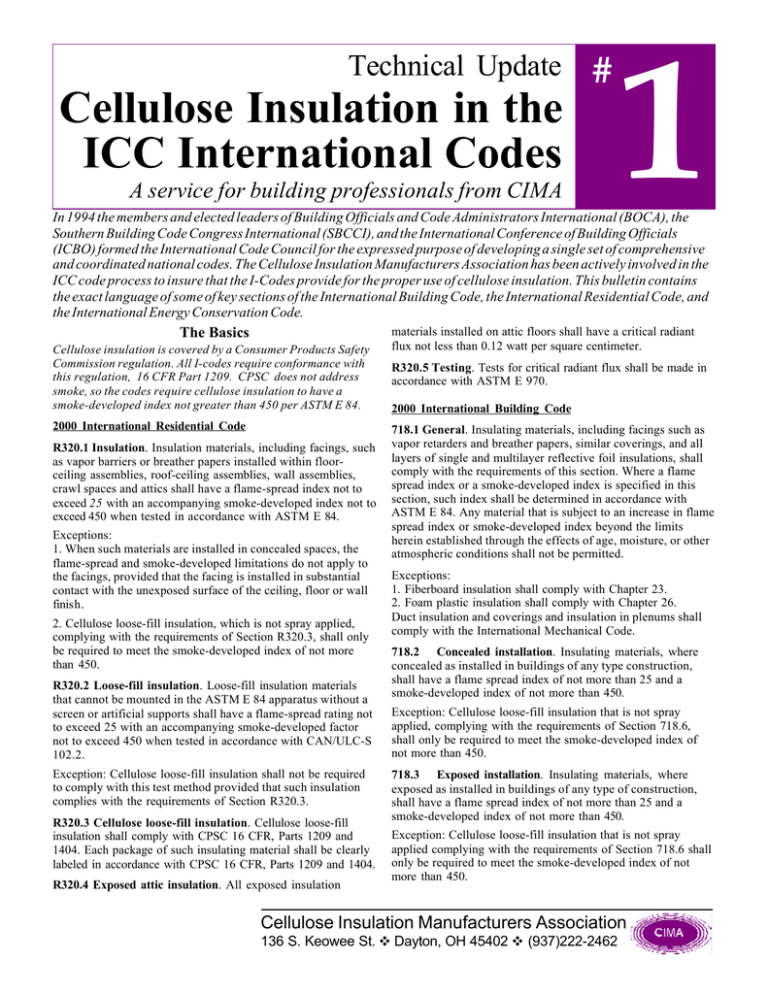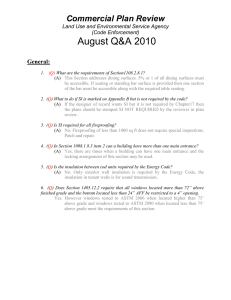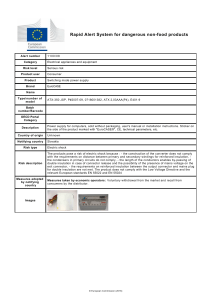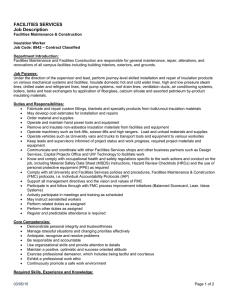Technical Update: Cellulose Insulation in the ICC International Codes
advertisement

Technical Update Cellulose Insulation in the ICC International Codes # A service for building professionals from CIMA 1 In 1994 the members and elected leaders of Building Officials and Code Administrators International (BOCA), the Southern Building Code Congress International (SBCCI), and the International Conference of Building Officials (ICBO) formed the International Code Council for the expressed purpose of developing a single set of comprehensive and coordinated national codes. The Cellulose Insulation Manufacturers Association has been actively involved in the ICC code process to insure that the I-Codes provide for the proper use of cellulose insulation. This bulletin contains the exact language of some of key sections of the International Building Code, the International Residential Code, and the International Energy Conservation Code. The Basics Cellulose insulation is covered by a Consumer Products Safety Commission regulation. All I-codes require conformance with this regulation, 16 CFR Part 1209. CPSC does not address smoke, so the codes require cellulose insulation to have a smoke-developed index not greater than 450 per ASTM E 84. 2000 International Residential Code R320.1 Insulation. Insulation materials, including facings, such as vapor barriers or breather papers installed within floorceiling assemblies, roof-ceiling assemblies, wall assemblies, crawl spaces and attics shall have a flame-spread index not to exceed 25 with an accompanying smoke-developed index not to exceed 450 when tested in accordance with ASTM E 84. Exceptions: 1. When such materials are installed in concealed spaces, the flame-spread and smoke-developed limitations do not apply to the facings, provided that the facing is installed in substantial contact with the unexposed surface of the ceiling, floor or wall finish. 2. Cellulose loose-fill insulation, which is not spray applied, complying with the requirements of Section R320.3, shall only be required to meet the smoke-developed index of not more than 450. R320.2 Loose-fill insulation. Loose-fill insulation materials that cannot be mounted in the ASTM E 84 apparatus without a screen or artificial supports shall have a flame-spread rating not to exceed 25 with an accompanying smoke-developed factor not to exceed 450 when tested in accordance with CAN/ULC-S 102.2. Exception: Cellulose loose-fill insulation shall not be required to comply with this test method provided that such insulation complies with the requirements of Section R320.3. R320.3 Cellulose loose-fill insulation. Cellulose loose-fill insulation shall comply with CPSC 16 CFR, Parts 1209 and 1404. Each package of such insulating material shall be clearly labeled in accordance with CPSC 16 CFR, Parts 1209 and 1404. R320.4 Exposed attic insulation. All exposed insulation materials installed on attic floors shall have a critical radiant flux not less than 0.12 watt per square centimeter. R320.5 Testing. Tests for critical radiant flux shall be made in accordance with ASTM E 970. 2000 International Building Code 718.1 General. Insulating materials, including facings such as vapor retarders and breather papers, similar coverings, and all layers of single and multilayer reflective foil insulations, shall comply with the requirements of this section. Where a flame spread index or a smoke-developed index is specified in this section, such index shall be determined in accordance with ASTM E 84. Any material that is subject to an increase in flame spread index or smoke-developed index beyond the limits herein established through the effects of age, moisture, or other atmospheric conditions shall not be permitted. Exceptions: 1. Fiberboard insulation shall comply with Chapter 23. 2. Foam plastic insulation shall comply with Chapter 26. Duct insulation and coverings and insulation in plenums shall comply with the International Mechanical Code. 718.2 Concealed installation. Insulating materials, where concealed as installed in buildings of any type construction, shall have a flame spread index of not more than 25 and a smoke-developed index of not more than 450. Exception: Cellulose loose-fill insulation that is not spray applied, complying with the requirements of Section 718.6, shall only be required to meet the smoke-developed index of not more than 450. 718.3 Exposed installation. Insulating materials, where exposed as installed in buildings of any type of construction, shall have a flame spread index of not more than 25 and a smoke-developed index of not more than 450. Exception: Cellulose loose-fill insulation that is not spray applied complying with the requirements of Section 718.6 shall only be required to meet the smoke-developed index of not more than 450. Cellulose Insulation Manufacturers Association 136 S. Keowee St. v Dayton, OH 45402 v (937)222-2462 718.3.1 Attic floors. Exposed insulation materials installed on attic floors shall have a critical radiant flux of not less than 0.12 watt per square centimeter when tested in accordance with ASTM E 970. 718.4 Loose-fill insulation. Loose-fill insulation materials that cannot be mounted in the ASTM E 84 apparatus without a screen or artificial supports shall comply with the flame spread and smoke-developed limits of Sections 718.2 and 7183 when tested in accordance with CAN/ULC S 102.2. Exception: Cellulose loose-fill insulation shall not be required to comply with this test method, provided such insulation complies with the requirements of Section 718.6. 718.6 Cellulose loose-fill insulation. Cellulose loose-fill insulation shall comply with CPSC 16 CFR, 1209 and CPSC 16 CFR, 1404. Each package of such insulating material shall be clearly labeled in accordance with CPSC 16 CFR, 1209 and CPSC 16 CFR, 1404. Fire Resistance Several sections of the I-Codes recognize the superior fire resistance of walls insulated with cellulose insulation. 2000 International Building Code & 2001 Amendments to the IBC 711.3.1 Through penetrations. Through penetrations of fireresistance-rated walls shall comply with Section 711.3.1.1or 711.3.1.2. Exception: Where the penetrating items are steel, ferrous or copper pipes or steel conduits, the annular space between the penetrating item and the fire-resistance-rated wall shall be permitted to be protected as follows: 1. [Not relevant to cellulose insulation] 2. The material used to fill the annular space shall prevent the passage of flame and hot gases sufficient to ignite cotton waste where subjected to ASTM E 119 time temperature fire conditions under a minimum positive pressure differential of 0.01 inch (2.49 Pa) of water at the location of the penetration for the time period equivalent to the fire-resistance rating of the construction penetrated. Tests conducted by Omega Point Laboratories (Project No. 16094-105451) on October 25, 1999, qualify cellulose insulation per Exception 2. 711.3.2 Membrane Penetrations. Membrane penetrations shall comply with Section 711.3.1. Where walls and partitions are required to have a minimum 1-hour fire-resistance rating, recessed fixtures shall be installed such that the required fire resistance will not be reduced. Exceptions: 1. Steel electrical boxes that do not exceed 16 square inches (0.0103 m2) in area provided the total area of such openings does not exceed 100 square inches (0.0645 m2) for any 100 square feet (9.29 m2) of wall area. Outlet boxes on opposite sides of the wall shall be separated as follows: 1.1 By a horizontal distance of not less than 24 inches (610 mm); 1.2 By a horizontal distance of not less than the depth of the wall cavity where the wall cavity is filled with cellulose loose-fill or mineral fiber insulation; Section 720 Calculated Fire Resistance Table 720.6.2(5) Time Assigned for Additional Protection Description of Additional Protection Fire resistance (min) Add to the fire resistance rating of wood stud walls if the spaces between the studs are completely filled with glass fiber, mineral wool batts weighing not less than 15 2 lb/cu ft (0.6 lb/sq ft of wall surface) or rock wool or slag material wool batts weighing not less than 3.3 lb/cu ft (1 lb/sq ft of wall surface), or cellulose insulation having a nominal density not less than 2.6 lb/cu ft. Moisture Protection The latest findings of building science indicate that many traditional moisture control practices are not only ineffective, but may actually be detrimental to the moisture performance of building assemblies. The IBC and the IECC give building officials latitude to apply the growing base of moisture performance information to allow moisture control strategies that are appropriate for their jurisdictions and the design and components of specific assemblies. It is the position of CIMA and most cellulose insulation manufacturers that vapor retarders are unnecessary, and may actually cause moisture problems, with cellulose insulated walls in all but the most extreme cold climates 2000 International Building Code 1403.3 Vapor retarders. An approved interior noncorrodible vapor retarder shall be provided. Vapor retarders shall be tested in accordance with ASTM E96. Exceptions: 1. Where other approved means to avoid condensation and leakage of moisture are provided. 2000 International Energy Conservation Code 502.1.1 Moisture control. The design shall not create conditions of accelerated deterioration from moisture condensation. Frame walls, floors and ceilings not ventilated to allow moisture to escape shall be provided with an approved vapor retarder having a maximum permeance rating of 1.0 perm (5.72 x l0-8 g/Pa s m2) when tested in accordance with Procedure A of ASTM E 96. The vapor retarder shall be installed on the warm-in-winter side of the thermal insulation. Exceptions: 1. In construction where moisture or its freezing will not damage the materials. 2. Where the county in which the building is being constructed is considered a hot and humid climate area and identified as such in Figures 302.1(1) through 302.1(51). 3. Where other approved means to avoid condensation in unventilated framed wall, floor, roof and ceiling cavities are provided. Cellulose. . .it's naturally better insulation!



